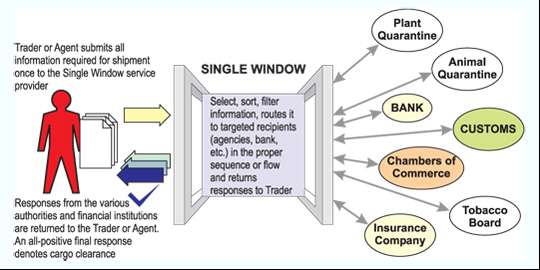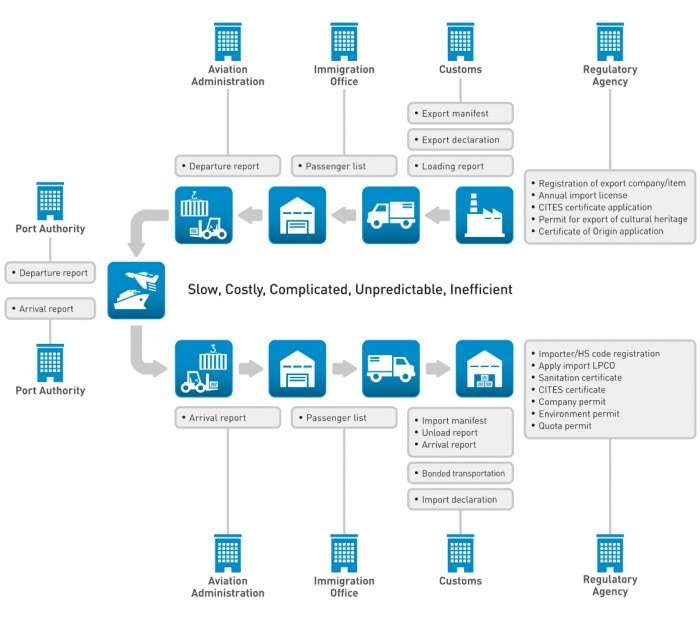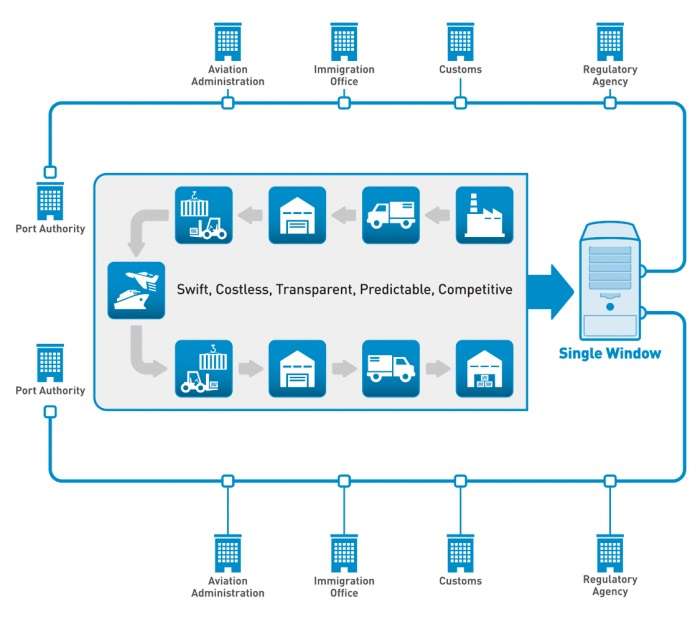Single-window system
The single-window system is a trade facilitation idea. As such, the implementation of a single window system enables international (cross-border) traders to submit regulatory documents at a single location and/or single entity. Such documents are typically customs declarations, applications for import/export permits, and other supporting documents such as certificates of origin and trading invoices.
The main value proposition for having a single window for a country or economy is to increase the efficiency through time and cost savings for traders in their dealings with government authorities for obtaining the relevant clearance and permit(s) for moving cargoes across national or economic borders. In a traditional pre-single-window environment, traders may have had to contend with visits and dealings with multiple government agencies in multiple locations to obtain the necessary papers, permits, and clearances to complete their import or export processes.
A common definition of the term "single window" is:
"A facility that allows parties involved in trade and transport to lodge standardized information and documents with a single entry point to fulfill all import, export, and transit-related regulatory requirements. If information is electronic then individual data elements should only be submitted once."
The concept is recognised and promoted by several world organisations that are concerned with trade facilitation. Amongst these are the United Nations Economic Commission for Europe (UNECE) and its Centre for Trade Facilitation and Electronic Business (UN/CEFACT), World Customs Organisation (WCO), the United Nations Network of Experts for Paperless Trade and Transport in Asia and the Pacific (UNNExT),[1] SITPRO Limited of the United Kingdom and the Association of Southeast Asian Nations (ASEAN).
The diagram below illustrates an example of an implementation of a Single Window system within a country or economy.

There are so many actors and procedures and the time and cost for trade international. Thereason why trade international need that relatively more than domestic trade, is needs for the inevitable controls of cross border regulatory Agencies(CBRAs). This inevitable various controls can be carried out through Single Window supporting by information technology, and optimized process. You can understand Single Window's Benefits from below two diagrams, which one is about before Single Window, and the other one is about after Single Window.


Benefits
A single window service aims to deliver specific benefits to the main communities and stakeholders in cross-border trade.
- Government
- Customs
- Permit-issuing agencies
- Ministries: Ministries (and other trade monitoring bodies) may be able to obtain cross-border trade-related data and statistics in a comprehensive and timely manner from the single window service provider
- Shipping and forwarding community
- Ship arrival notice
- IMO FAL forms:
- General declaration
- Ship's stores declaration
- Crew's effects declaration
- Crew list
- Passenger list
- Electronic ship clearance
- Shippers and traders
- Banking and insurance community
Known IT Systems
- CrimsonLogic Trade Facilitation / Single Window Systems
- Orbus Single window system / GAINDE 2000 paperless trade platform
- Intrasoft e-Customs Framework
- SOGET Single Window System
- SGS Single Window System
- ADVANCE Single Window System
- Crown Agents Single Window System
- UNI-PASS Single Window System - Korean Single Window System
- VUCEM - Mexican Foreign Trade Single Window
- Webb Fontaine Single Window System
References
Documents
- UNNExT Single Implementation Window Toolkit for Trade Facilitation
- UNECE brochure on the Single Window concept
- UN/CEFACT Recommendation No. 33 – Recommendation and Guidelines on establishing a Single Window
- Ten Years of Single Window Implementation
- The World Customs Organisation (WCO) perspective on the Single Window Concept
- Single Window Planning and Implementation Guide